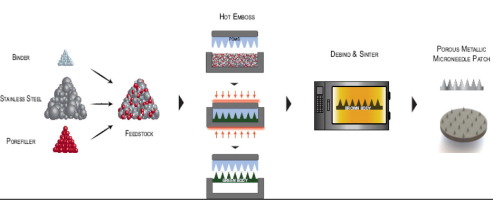Acta Biomaterialia ( IF 9.7 ) Pub Date : 2018-09-08 , DOI: 10.1016/j.actbio.2018.09.007 Ellen M. Cahill , Shane Keaveney , Vivien Stuettgen , Paulina Eberts , Pamela Ramos-Luna , Nan Zhang , Manita Dangol , Eoin D. O'Cearbhaill

|
Metallic-based microneedles (MNs) offer a robust platform for minimally invasive drug delivery and biosensing applications due to their mechanical strength and proven tissue and drug compatibility. However, current designs suffer from limited functional surface area or challenges in manufacturing scalability. Here, porous 316L stainless steel MN patches are proposed. Fabricated through a scalable manufacturing process, they are suitable for storage and delivery of drugs and rapid absorption of fluids for biosensing. Fabrication of these MNs involves hot embossing a patch of stainless steel-based feedstock, sintering at 1100 °C and subsequent electropolishing. Optimisation of this manufacturing process yields devices that maintain mechanical integrity yet possess high surface area and associated porosity (36%) to maximise loading capacity. Similarly, a small pore size has been targeted (average diameter 2.22 μm, with 90% between 1.56 μm and 2.93 μm) to maximise capillarity and loading efficiency. This porous network has a theoretical wicking rate of 4.7 μl/s and can wick-up 27±5 μl of fluid through capillary action which allows for absorption of pharmaceuticals for delivery. When inserted into a metabolite-loaded skin model, the MNs absorbed and recovered 17±3 μl of the metabolite solution. The drug delivery performance of the porous metallic MNs (22.4±4.9µg/cm2) was found to be three fold higher than that of topical adminsitration (7.1±4.3µg/cm2). The porous metallic MN patches have been shown to insert into porcine skin under a 19 N load. These results indicate the potential of design-for-manufacturing porous stainless steel MNs in biosensing and drug delivery applications.
Statement of Significance
Microneedles are micro-scale sharp protrusions used to bypass the stratum corneum, the skin’s outer protective layer, and painlessly access dermal layers suitable for drug delivery and biosensing. Despite a depth of research in the area we have not yet seen large-scale clinical adoption of microneedle devices. Here we describe a device designed to address the potential barriers to adoption seen by other microneedles devices. We have developed a scalable, cost effective process to produce medical grade stainless steel microneedle patches which passively absorb and store drugs or interstitial fluid though a porous network and capillary action. This device, with low manufacturing and regulatory burdens may help the large-scale adoption of microneedles.
中文翻译:

具有互连孔隙率的金属微针:用于生物传感和药物输送的可扩展平台
基于金属的微针(MNs)具有机械强度以及经过验证的组织和药物相容性,因此为微创药物输送和生物传感应用提供了一个强大的平台。然而,当前的设计遭受功能表面积有限或制造可扩展性方面的挑战。在这里,提出了多孔的316L不锈钢MN贴片。通过可扩展的制造工艺制造,它们适用于药物的存储和输送以及流体的快速吸收以进行生物传感。这些MN的制造涉及对不锈钢基原料进行热压纹,在1100°C下烧结以及随后的电抛光。通过优化该制造工艺,可以生产出既能保持机械完整性,又具有高表面积和相关孔隙率(36%)的装置,从而可以最大程度地提高装载能力。同样,目标是小孔径(平均直径2.22μm,其中90%在1.56μm和2.93μm之间),以最大程度地提高毛细作用和加载效率。该多孔网络的理论芯吸速率为4.7μl/ s,可通过毛细作用芯吸27±5μl的流体,从而吸收药物用于输送。当插入到负载有代谢产物的皮肤模型中时,MN吸收并回收了17±3μl的代谢产物溶液。多孔金属微胶囊的释药性能(22.4±4.9µg / cm 速度为7μl/ s,可通过毛细作用吸收27±5μl的液体,从而吸收药物用于输送。当插入到负载有代谢产物的皮肤模型中时,MN吸收并回收了17±3μl的代谢产物溶液。多孔金属微胶囊的释药性能(22.4±4.9µg / cm 速度为7μl/ s,可通过毛细作用吸收27±5μl的液体,从而吸收药物用于输送。当插入到负载有代谢产物的皮肤模型中时,MN吸收并回收了17±3μl的代谢产物溶液。多孔金属微胶囊的释药性能(22.4±4.9µg / cm2)被发现比局部给药(7.1±4.3μg/ cm 2)高三倍。多孔金属MN斑块已显示在19 N的负荷下插入猪皮肤。这些结果表明在生物传感和药物递送应用中设计制造多孔不锈钢MN的潜力。
重要声明
微针是微型的尖锐突起,用于绕过角质层,皮肤的外部保护层以及无痛地进入适合药物输送和生物传感的真皮层。尽管在该领域进行了深入的研究,但我们尚未看到微针装置在临床上的大规模采用。在这里,我们描述了一种旨在解决其他微针设备所面临的潜在采用障碍的设备。我们已经开发出一种可扩展的,具有成本效益的工艺,以生产医用级不锈钢微针贴片,该贴片通过多孔网络和毛细作用被动地吸收和存储药物或组织液。该设备具有较低的制造和管理负担,可以帮助大规模采用微针。


























 京公网安备 11010802027423号
京公网安备 11010802027423号